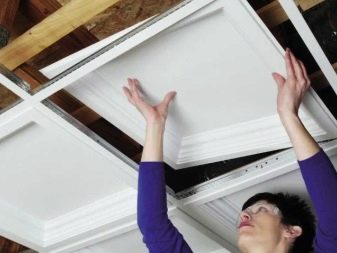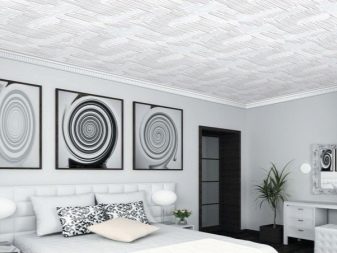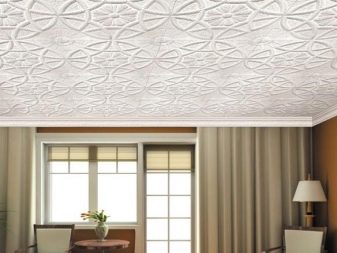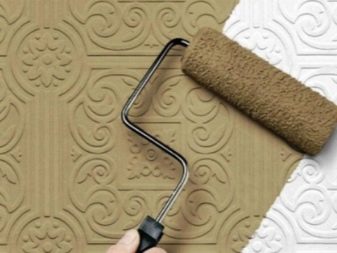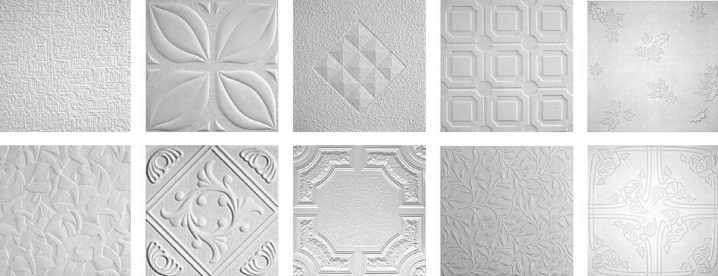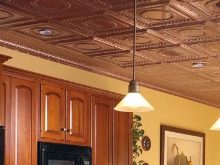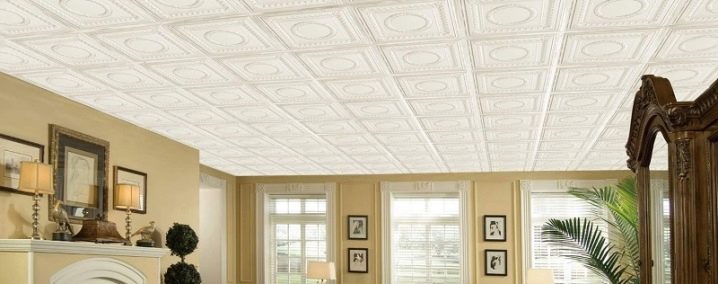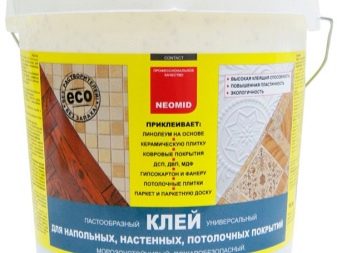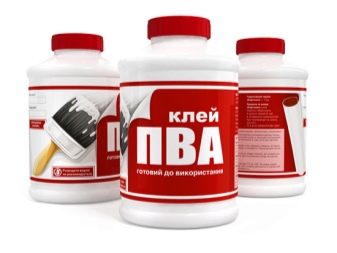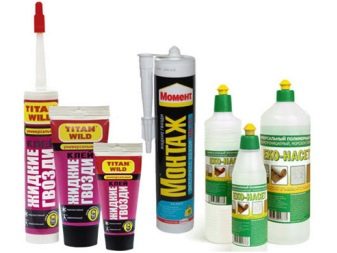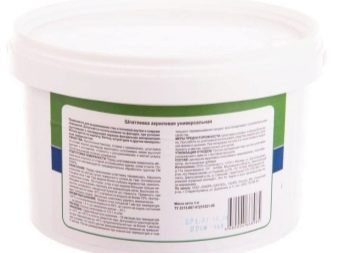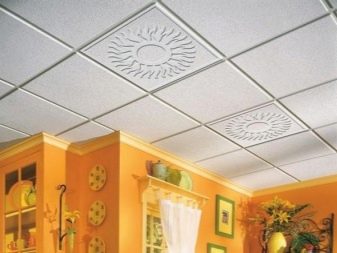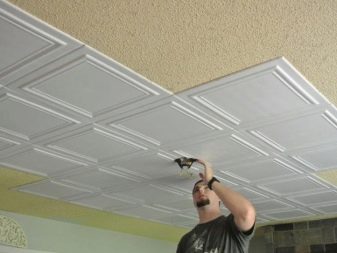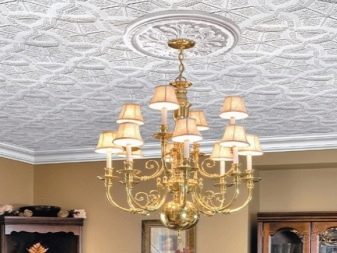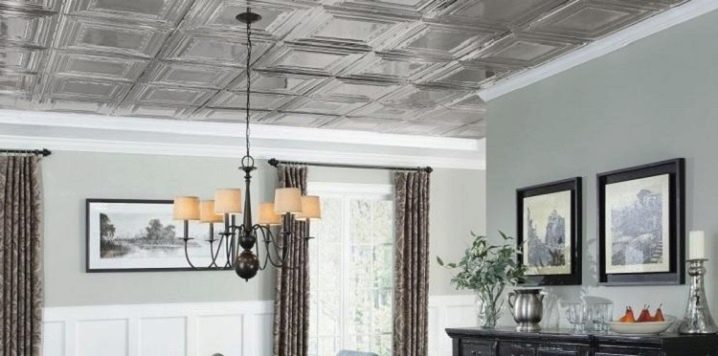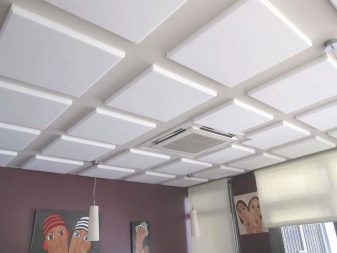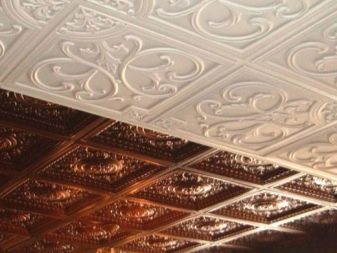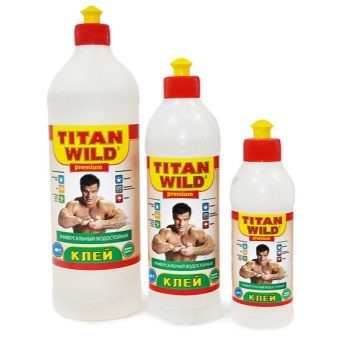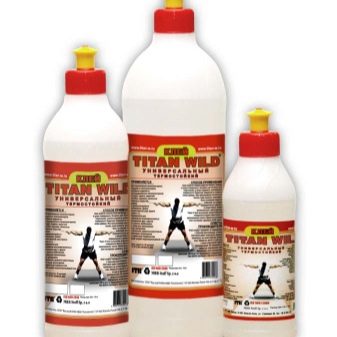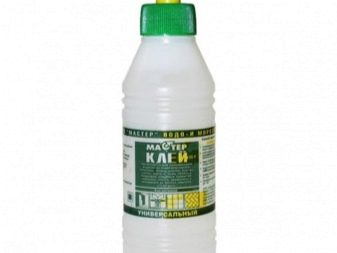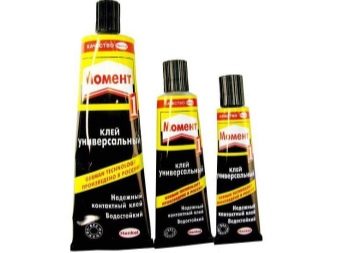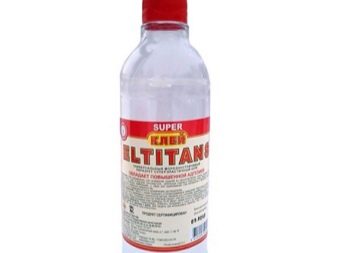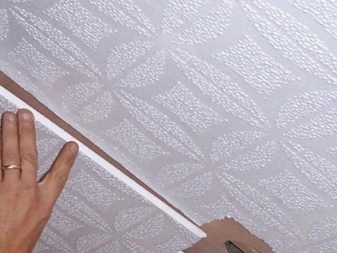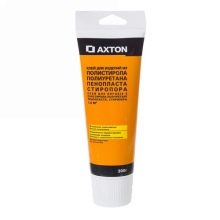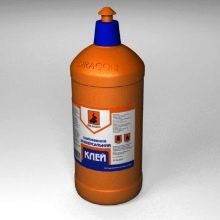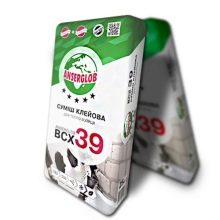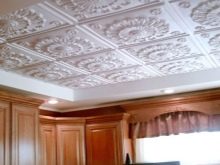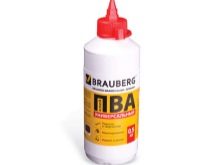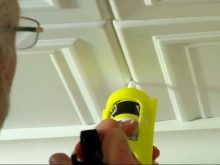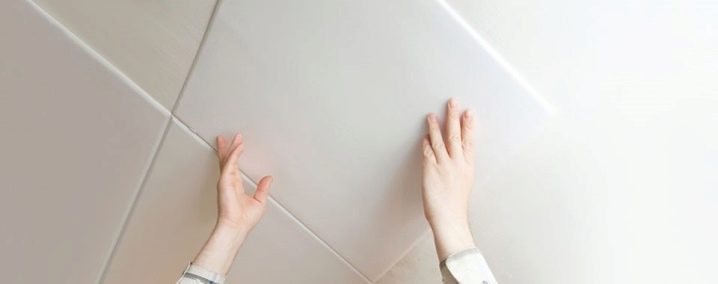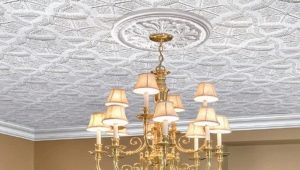How to choose glue for ceiling tiles from foam?
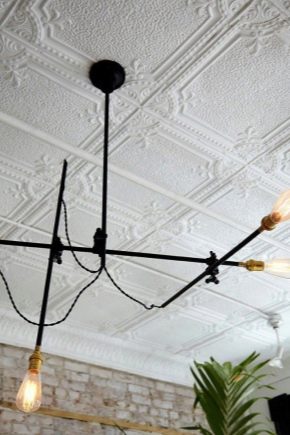
The ceiling is almost the main headache for the owners during the renovation of the apartment, because its flaws are clearly visible from every corner of the room, and it is not easy to repair it because of the horizontal position of the surface. With the advent of ceiling foam tiles, this problem was largely resolved - this option looks aesthetically pleasing, is inexpensive, undemanding on the surface to which it is glued, does not imply any special installation efforts.
It is possible to repair the ceiling to an aesthetic state even without the skills of construction and repair work, but in order for the result to be reliable and durable, you need to choose the right special glue.
Ceiling tile features
To choose the right glue, you first need to clearly understand what a ceiling tile.In contrast to ceramic tile, such products are almost always made of expanded polystyrene, a chemical that many mistakenly call foam plastic for its similarity in appearance and in properties. Traditionally, it is produced in packs of several plates, each of which is about 1 cm thick, and the dimensions are usually 50 to 50 cm.
There are also completely flat plates, but more often the manufacturer decorates them with one or another volumetric ornament in the assortment. In addition, you can choose a special ceiling baseboards of the same material and even sockets that will ideally harmonize with such repairs.
Traditionally, such material is available in three varieties:
- From extruded polystyrene foam. Such a product belongs to the most accessible category, since its production does not require either a large amount of raw materials or complex equipment, because even a lot of pressure is not used in the manufacturing process. The result is appropriate: usually stamped tile is not the highest strength.
- From injection polystyrene. In this case, more complex equipment is used, giving a significant pressure, as a result of which a higher density is achieved, and, accordingly, durability.This type of tile is strong enough to be painted with water-based paint.
- Extruded foam. This kind of foam has maximum strength, as it is made using an extruder - a special machine that can mix the liquid, carefully sucking air bubbles out of it. The raw material is still liquid foam, so the finished tile does not contain voids at all, even small ones. Given the high cost of manufacturing such products, the manufacturer usually also laminates the outer surface of the panel so that it can be used without any harm in wet areas - in the bathroom or in the kitchen. When choosing such a building material, even subsequent painting is not required, since the tile is often painted by the manufacturer.
With the right choice of tiles and glue for it, you can get a repair of the ceiling with the following advantages:
- Elementary installation, which everyone can do, as well as ease of gluing on any type of surface.
- High aestheticism of finishing - up to the natural imitation of real stucco.Unlike suspended ceilings, the level of the height of the room is almost not reduced.
- The sound and thermal insulation properties of such a thin barrier exceed all expectations.
- Contrary to its artificial origin, polystyrene foam tiles are completely harmless to humans and can even be used in the nursery.
- A wide range of such products allows each owner to choose this building material both in appearance and in its own financial capabilities.
Unfortunately, even such a perfect type of decoration has its own drawbacks - although there are few of them, and if you want, you can get around them. First of all, expanded polystyrene is quite easily ignited, and in the process of burning it also releases toxic fumes, therefore, it is necessary to finish the ceiling only in those rooms where the probability of a fire is extremely small.
In addition, the foam does not allow air, which in conditions of high humidity can contribute to the development of colonies of the fungus, however, ease of installation and dismantling, as well as the low cost of such repairs only contribute to more frequent replacement.
Types of glue
Taking into account all the necessary characteristics, four glue options are best suited for ceiling trimming with foam plastic:
- Universal. The very name of such an adhesive clearly says: this mixture will glue together anything, that is, this situation will also work. This glue is very viscous and dries very quickly, and also has a relatively low consumption. Nevertheless, there is also a drawback - a pungent smell that requires airing during operation.
- Polyvinyl acetate. Behind a complex name lies an ordinary PVA, as well as its more complex construction relative - bustilat. This option is distinguished by the absence of a sharp odor and perfectly fixes the tile on the ceiling, and also pleases with low cost. However, one should take into account the much increased consumption, because with this glue the whole tile and the entire ceiling are coated. In addition, the drying process will be longer.
- Liquid Nails. In combination with a special glue gun, this solution is considered to be the best for gluing ceiling tiles, since it not only provides a reliable grip at a low flow rate, but also allows you to seal any joints.The only disadvantage of this glue is one, but very significant - its purchase significantly increases the cost of the project.
- Acrylic putty. It is used mainly for gluing transparent plates, it is also very well suited for the installation of ceiling plinths.
Criterias of choice
First of all, it is necessary to thoroughly clean the ceiling from dust, fragments of old repairs, loose pieces of putty and similar unreliable elements that can interfere with the normal adhesion of tiles and ceilings. There is a list of criteria, compliance with which will help to glue the tile to the ceiling, even if the glue is homemade.
These characteristics include:
- Fast freeze. The tile is attached to a horizontal surface, and until the glue dries, it will not stick without the help of a master. He cannot hold more than one tile at a time, so it is better to choose glue that hardens within a minute or two - the speed of the work and its level of complexity directly depend on it.
- High viscosity. The tile has a certain weight, albeit small, and therefore too liquid a substance can not hold it at all - it just does not grab.The denser (and heavier) the finish, the thicker the adhesive is needed.
- "Invisible" color. As a result of repair, the owners probably want to get a solid ceiling, on which dots or stripes of glue would not stand out with a different color. You can hide the effects of gluing with white or transparent glue.
- Universality by materials. Very many varieties of glue have high adhesion only with respect to a certain type of material, while gluing the ceiling tile involves the connection of fundamentally different surfaces - expanded polystyrene with concrete, gypsum cardboard, and wood. The adhesive must be able to adhere to the materials used in the room, the minimum condition for the purchase in the case of most apartments is the guaranteed high-quality gluing of foam boards to concrete.
- No solvent in the composition! Some manufacturers prefer to use a concentrated solid adhesive, which is diluted to a liquid state using a solvent. Polyfoam from which the future ceiling covering is made cannot withstand contact with such an ingredient.
Experts say that the size of the surface to which the ceiling polystyrene tiles will be glued also matters. On the new, smooth surface (as such, often acts just-installed ceiling of plasterboard) plates fall better due to maximum contact, but the adhesive substance is nothing to grab.
When sticking to the old surface, the problem may turn out to be the opposite - due to the radical unevenness of the ceiling, the natural tendency of the tile to straighten out will not promote adhesion. For this reason, both perfect smoothness and strong surface roughness equally require the most viscous and quick-drying type of glue.
Manufacturers
Many consumers who are not professionals from the world of repair prefer to choose glue not so much by its type and quality as by the name of the brand, which has managed to establish itself among a wide range of consumers. In many respects this is true, as masters who regularly glue the ceiling with polystyrene plates usually leave approximately the same reviews about each individual brand of adhesive products.
One of the leaders in this area can definitely be called glue brand "Titan". Its advantages lie on the surface - it is well suited for bonding polystyrene with a variety of building materials, and is also designed to work under any atmospheric conditions, since neither temperature nor humidity affect its properties. Consumption of such products is quite low, while the manufacturer has taken care of the invisibility of the composition and its stability in wet conditions. Traditionally, the only disadvantage of a very good product in general is its price.
Also widely spread glue "Master"but its main advantage is just a low price. This glue is a vivid example of how the manufacturer’s crooked hands can, with an approximately similar composition (but using cheap additives) play a role in determining the quality of a product. First of all, the “Master” has a very unpleasant odor, and even airing does not always allow for refreshing the atmosphere in the room. Moreover, the drying rate of such an adhesive is significantly higher than that of Titan, which complicates the work.Some experts also point to the possibility of subsequent unstuck or displacing tiles.
Some masters in the process of repair even use the well-known Moment glue, and in a sense, this decision is justified, because this substance has the highest adhesive abilities, dries very quickly, is consumed sparingly, and is inexpensive.
However, it is precisely his high drying rate that can become a certain problem, because such an adhesive does not give the master any opportunity to correct his own mistakes - he instantly grabs, to correct the flaws and curved seams will not work.
For those who are not afraid to use Chinese glue in the repair process, you should pay attention to brand products "Eltitans". With its very low, typically Chinese value, this glue has quite good qualities - first of all, good adhesion to most types of surfaces. "Eltitans" is also good in the formation of waterproof joints, which makes the repair of the ceiling more durable and helps to solve the problem of the appearance of the fungus.Glued joints have sufficient elasticity, so that the renovated ceiling retains its original appearance in any atmospheric conditions - in particular, the plates do not peel off even in the cold.
These are the most commonly used types of glue in our country, but many other manufacturers also deserve attention. As a worthy alternative to the above brands, we should also mention “Eco-Naset”, Axton, “Dragon”, Power and Anserglob.
Application tips
In some cases, not the most successful result of sticking ceiling tiles is caused not by an erroneous choice of expanded polystyrene or glue, but simply by incorrectly performed work.
For this reason, you should pay attention to the following recommendations:
- In the process of gluing only at first glance there is nothing difficult - in fact, the instructions should be carefully read even before choosing the glue. Different types of glue among the above described have different ways of gluing, necessary for optimum setting.
- Most polymer-based adhesives imply special bonding, in which a tile with an already applied layer of glue is first simply applied to the ceiling for half a minute or a minute, then removed at the same time, and only then finally glued to the same place.With the help of such a clever procedure, it is possible to somewhat compact and dry the glue; as a result, the second application is marked by a very fast setting.
- The best way to apply glue is around the perimeter, with a solid stripe without breaks. Dotting is allowed only with the purchase of very expensive, quickly setting glue, but then it is better not to use cheap thin plates, since there is a great risk of their deformation even when gluing.
- Even if the previous ceiling finish seems securely fixed, it is better to remove it before sticking a new ceiling tile. Firstly, it is impossible to predict how long the old finish would last even by itself, secondly, after adding polystyrene, the load on it will increase even more, so that the new repair can easily fall off with the old.
- If the whole tile is glued fairly well, then it is even harder to glue its sliced pieces and with the observance of the correctness of all the seams, and such cutting looks somewhat worse. For this reason, it is advised to glue polystyrene tiles, starting from the angle that immediately catches the eye upon entering the room.
If the layout of the room is too complicated for such decisions, it is necessary to glue the tiles diagonally from the chandelier, but this will increase the consumption of tiles, as well as the complexity and duration of the work.
See how to quickly glue the ceiling tile in the next video.
